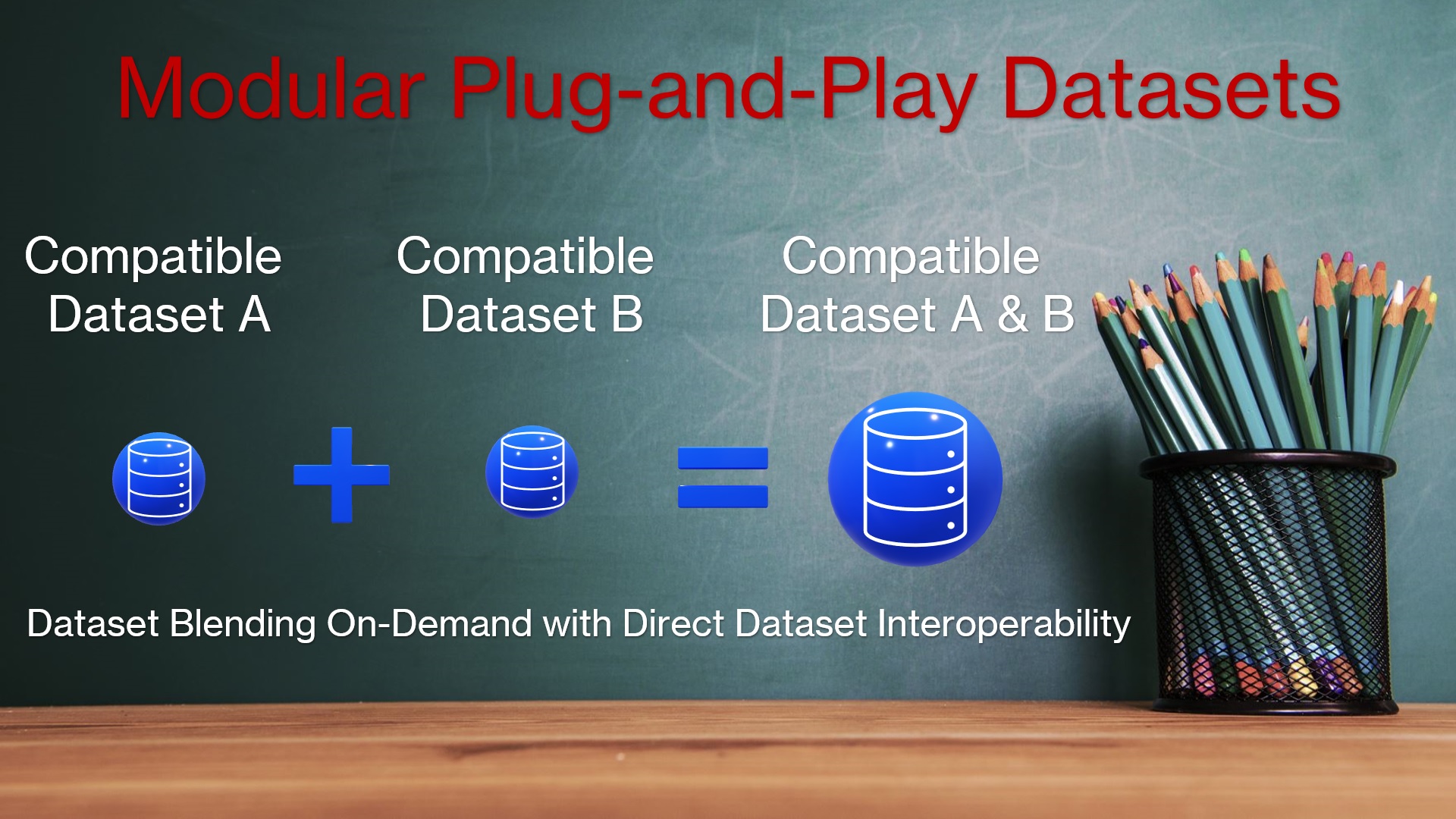Maxxphase Compatible Datasets are Modular Plug-and-Play Datasets
Modular plug-and-play datasets are compatible datasets designed specifically to be directly interoperable with each other. Any of the compatible modular datasets can be seamlessly combined, on-demand, to retrieve whatever data is requested. These modular datasets, alone or in dynamic combinations, are also designed to provide all the functionality of a data warehouse.
We have determined that siloed datasets simply lack the master data and metadata commonality needed to directly share their data with other datasets. Our data products, Maxxphase Data Compatibility Standards, are non-invasively added to each disparate dataset to provide the master data and metadata commonality making the dataset compatible. When a dataset is encapsulated with a series of Data Compatibility Standards, the dataset becomes modularized. All direct data interoperability between compatible datasets is through the Data Compatibility Standards.
Businesses now have direct access to whatever data they need, no matter what compatible datasets are involved. Beyond that, there are no programmed data flow dependencies among datasets. All datasets remain independent, which results in amazing agility not currently seen without plug-and-play functionality. No data flow datasets greatly reduce the resources needed for development and maintenance while increasing data trust.

Business and IT Agility
Ever had a problem onboarding a new data system or retiring an outdated data system? The difficulty emanates from disparate data systems bound together with hand-crafted data flow software needed to integrate their data. These data systems and their data integration software have been named the Data Integration Hairball because of the complexity of their interdependence. This siloed data architecture is stagnant because of the difficulty and expense of making changes.
Plug-and-play data systems feature no code-standardized data junctions between compatible modular datasets. These standardized data junctions do not require nor want data movement, data preparation, or data transformations. Developing and maintaining modular plug-and-play datasets is very efficient, cost-effective, and flexible compared to any Data Integration Hairball.
These compatible modular datasets are components that spontaneously form a single consistent Compatible Data Fabric. Since the direct data junctions are standardized, any compatible data systems can easily be added or removed from the Compatible Data Fabric. Plug-and-play functionality creates a compatible data architecture that is very agile.
Compatible Dataset Features
All compatible datasets are encapsulated within a set of Maxxphase Data Compatibility Standards. These standards were designed to deliver several important enhancements to the original dataset.
First, these Data Compatibility Standards provide a common foundation of master data and metadata for each compatible dataset. The data in a compatible dataset is integrated with any other compatible datasets' data through their copies of the common foundation.
Second, the Data Compatibility Standards support extensive direct dataset interoperability through their copies of the common foundation. Compatible datasets form direct and dynamic data access paths among them. These data access paths are the "threads" that weave the compatible datasets into a Compatible Data Fabric. Since the data is integrated across compatible datasets and the datasets are directly interoperable, you now have a 360ᴼ view of all your data.
Third, we designed the Data Compatibility Standards to support business intelligence and analytics functionality. Each compatible dataset is analytics-ready as it supports multidimensional analysis. Since these datasets are extensively directly interoperable, and the data from multiple compatible datasets are integrated, these compatible datasets can be blended or harmonized.
Finally, a compatible dataset interacts with any other compatible dataset through its common foundation of master data and metadata. These direct and dynamic interactions give each compatible data system its plug-and-play capabilities within the Compatible Data Fabric. A new compatible dataset can be added to the Compatible Data Fabric and immediately directly interacts with all other compatible datasets within the data fabric.

Business and IT Agility
Ever had a problem onboarding a new data system or retiring an outdated data system? The difficulty emanates from disparate data systems bound together with hand-crafted data flow software needed to integrate their data. These data systems and their data integration software have been named the Data Integration Hairball because of the complexity of their interdependence. This siloed data architecture is stagnant because of the difficulty and expense of making changes.
Plug-and-play data systems feature no code-standardized data junctions between compatible modular datasets. These standardized data junctions do not require nor want data movement, data preparation, or data transformations. Developing and maintaining modular plug-and-play datasets is very efficient, cost-effective, and flexible compared to any Data Integration Hairball.
These compatible modular datasets are components that spontaneously form a single consistent Compatible Data Fabric. Since the direct data junctions are standardized, any compatible data systems can easily be added or removed from the Compatible Data Fabric. Plug-and-play functionality creates a compatible data architecture that is very agile.
Datasets that Collaborate
Siloed datasets do not directly collaborate. Each dataset represents a set of compartmentalized data that is incompatible, and each offers a conflicting view of data. These conflicting views of data are a huge problem for business users; hence, the prominence of data integration to resolve these data conflicts. However, transformation-based data integration does not remove the conflicting data from the source, and in fact, further instantiates the isolation of your datasets from each other.
Maxxphase Data Compatibility provides standardized data and metadata commonality to each dataset needed to dynamically and directly connect these datasets. This data and metadata commonality resolves conflicting master data views across previously siloed datasets. Direct connections do not need data transformations. Since no data transformations are used in these connections, the datasets become directly interoperable. Direct interoperability means the data from one dataset can be seamlessly joined with the data from other datasets.
The first-ever directly interoperable datasets were designed and implemented by Maxxphase. Our patented data design and management methods produce these interoperable compatible datasets. Because of the design for extensive dataset interoperability, a consistent Compatible Data Fabric is spontaneously formed from any group of compatible datasets. With Maxxphase Data Compatibility, all your datasets now collaborate to provide a single trusted view of your business data and information whenever or wherever needed.
